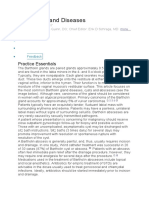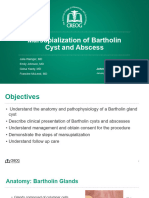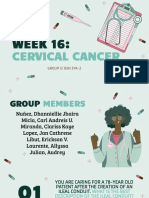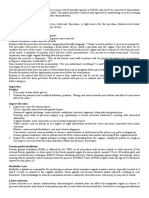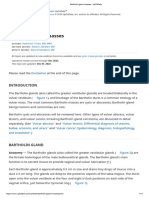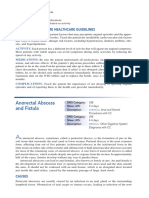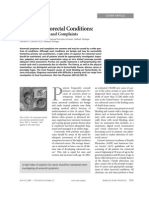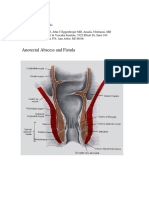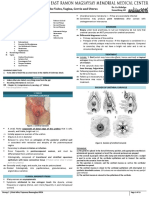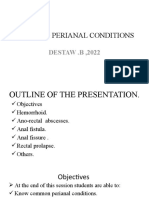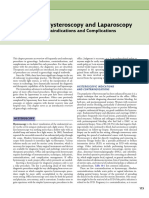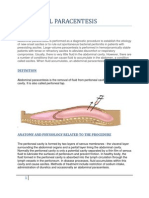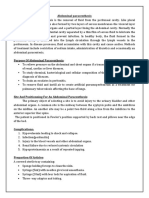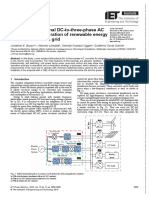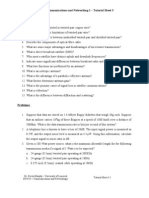Kelenjar Bartolini
Kelenjar Bartolini
Uploaded by
onlyfellaCopyright:
Available Formats
Kelenjar Bartolini
Kelenjar Bartolini
Uploaded by
onlyfellaCopyright
Available Formats
Share this document
Did you find this document useful?
Is this content inappropriate?
Copyright:
Available Formats
Kelenjar Bartolini
Kelenjar Bartolini
Uploaded by
onlyfellaCopyright:
Available Formats
NEWS REFERENCE EDUCATION
Connect F Muqhny
Reference
Print Share
Bartholin Gland Diseases
Author: Antonia Quinn, DO; Chief Editor: Erik D Schraga, MD more...
Overview Presentation DDx Workup Treatment Medication Follow-up Updated: Nov 8, 2012
Bartholin Gland Diseases
Author: Antonia Quinn, DO; Chief Editor: Erik D Schraga, MD
Background
Bartholin glands were first described by Caspar Bartholin, a Dutch anatomist, in 1677. These paired glands are approximately 0.5 cm in diameter and are found in the labia minora in the 4- and 8-oclock positions. Typically, they are nonpalpable. Each gland secretes mucus into a 2.5 cm duct. These two ducts emerge onto the vestibule at either side of the vaginal orifice, inferior to the hymen. Their function is to maintain the moisture of the vaginal mucosa's vestibular surface. This article focuses on the most common Bartholin gland diseases, cysts and abscesses. Although rare, carcinoma of the gland should be considered in women with an atypical presentation.
Pathophysiology
Bartholin glands are known to form cysts and abscesses in women of reproductive age. Cysts and abscesses are often clinically distinguishable. Bartholin cysts form when the ostium of the duct becomes obstructed, leading to distention of the gland or duct with fluid. Obstruction is usually secondary to nonspecific inflammation or trauma. The cyst is usually 1-3 cm in diameter and often asymptomatic, although larger cysts may be associated with pain and dyspareunia. [1]
Bartholin abscesses result from either primary gland infection or infected cyst. Patients with abscesses complain of acute, rapidly progressive vulvar pain. Studies have shown that these abscesses are usually polymicrobial and rarely attributable to sexually transmitted pathogens. Adenocarcinoma of the Bartholin glands is rare, accounting for 1-2% of all vulvar malignancies. Typically, this lesion presents as a gradually enlarging gland in an asymptomatic, postmenopausal woman. [2]
Epidemiology
Frequency
United States Approximately 2% of women of reproductive age will experience swelling of one or both Bartholin glands.
Mortality/Morbidity
Bartholin gland diseases are rarely complicated by systemic infection, sepsis, and bleeding secondary to surgical treatment. Missed diagnosis of malignancy may result in poorer outcome for those patients.
Race
No difference exists in the frequency of Bartholin gland diseases among different races.
Sex
Bartholin glands are present only in females.
Age
These diseases typically occur in women between the ages of 20 and 30 years. Bartholin gland enlargement in patients older than 40 years is rare and should be referred to a gynecologist for possible biopsy.
History
Patients with cysts may present with painless labial swelling. Abscesses may present spontaneously or after a painless cyst with the following symptoms: Acute, painful unilateral labial swelling Dyspareunia Pain with walking and sitting Sudden relief of pain followed by discharge (highly suggestive of spontaneous rupture)
Physical
The following physical examination findings are seen in Bartholin abscess, as shown in the image below.
Bartholin abscess. (Image courtesy of Dr. Gil Shlamovitz.)
Patients typically have an exquisitely tender, fluctuant labial mass with surrounding erythema and edema.
In some cases, areas of cellulitis surrounding the abscess may be present. Fever, though not typical in healthy patients, may occur. If the abscess has spontaneously ruptured, purulent discharge may be noted. If completely drained, no obvious mass may be observed. The following physical examination findings are seen in Bartholin cysts: Patients may have a painless, unilateral labial mass without signs of surrounding cellulitis. If large, the cyst may be tender. Discharge from ruptured cyst should be nonpurulent.
Causes
Uncomplicated Bartholin cysts are filled with nonpurulent mucous. Several studies have aimed to identify the most common bacterial pathogens responsible for Bartholin abscess formation. Studies from the 1970-1980s named Neisseria gonorrhoeae and Chlamydia trachomatis as common pathogens . More recent studies report the predominance of opportunistic bacteria such as Staphylococcusspecies, Streptococcus species, and most commonly, Escherichia coli.
Differential Diagnoses
Bartholin gland malignancy Chancroid Endometriosis Gartner duct cyst Gonorrhea Hematoma Hidradenoma Lipoma Sebaceous cysts Skene duct cyst Syphilis Vaginitis Vestibular mucous cysts Vulvar malignancy Warts, Genital
Laboratory Studies
In otherwise healthy, afebrile adults, blood tests are not necessary to evaluate an uncomplicated abscess or cyst. Sexually transmitted disease (STD) testing should be available at the request of the patient; however, Bartholin abscesses are very rarely caused by sexually transmitted pathogens. Cultures are rarely useful in treatment of abscess; furthermore, routine culturing of drained fluid is not recommended.
Procedures
The following features are suggestive of Bartholin gland malignancy. Patients who present with any of these features should be referred to a gynecologist for biopsy: Age older than 40 years Chronic or gradually progressive, painless mass Solid, nonfluctuant, painless mass Prior history of labial malignancy
Emergency Department Care
ED care should include a careful history and physical examination. A patient whose presentation is concerning for malignancy should receive close outpatient gynecologic follow-up for biopsy and possible excision. Those with an uncomplicated, asymptomatic cyst may be discharged with sitz bath instructions. Sitz baths (3 times daily) for several days may promote improvement with resolution or spontaneous rupture with resolution of the cyst. A Bartholin abscess is generally painful, and, thus, usually requires incision and drainage. Several techniques have been described,[3] but no large prospective studies have been performed to determine relative efficacy and complications. The goal of abscess treatment is to allow drainage and to prevent rapid reaccumulation of fluid. These techniques are described below. Refer to the Medscape Reference Clinical Procedures article Bartholin Abscess Drainage for Bartholin cyst management and further details. Patient comfort is essential to successful drainage. Use adequate anesthesia when incising any abscess. Attempting to do so without anesthesia results in an uncooperative patient, reduces the likelihood of successful drainage, and is unconscionable. Apply topical anesthetics to the mucosa followed by submucosal injection of local anesthetic (the minimum pain control required). Conscious sedation is often required and may be desirable. In patients with a large or complex abscess or for a complicated procedure, general anesthesia in the operating room (OR) may be required.
Incision and drainage
This technique consists of traditional incision, drainage, irrigation, and packing. Packing should be removed 2 days after the procedure. This technique requires multiple, painful packing changes and has a higher rate of abscess recurrence. Word catheter (shown in the image below)
Word catheter. (Image courtesy of Dr. Gil Shlamovitz.)
The word catheter was introduced in the 1960s. It is a small catheter with a saline inflatable balloon at the distal end. This procedure should be performed using sterile technique. Using an #11 blade a 0.5-cm incision is made into the abscess cavity on the mucosal surface of the labia minora. Contents of the cavity are expressed manually or by hemostat. The tip of the catheter is inserted into the cavity, and the balloon is inflated with 4 mL normal saline, as shown in the image below.
Word catheter with inflated balloon. (Image courtesy of Dr. Gil Shlamovitz.)
The free end of the catheter may be inserted into the vagina for patient comfort. The catheter allows for abscess drainage acutely and is left in place for several weeks to promote fistula formation. Patients should be advised to take sitz baths 2-3 times a day for 2 days following the procedure and to abstain from sexual intercourse until the catheter is removed. Simplicity is the technique's main advantage. It is tolerable to patients and allows restoration of gland function. A recent case report describes novel use of plastic tubing for abscess drainage when a Word catheter is not available. [4]
Marsupialization
This procedure is reserved for recurrent abscesses. The acute abscess is drained prior to marsupialization. This procedure consists of a wide incision of the mass followed by suturing the inner edge of the incision to external mucosa. This complicated procedure is usually performed by a gynecologist or urologist in the OR.
Excision
This procedure requires excision of the Bartholin gland and surrounding tissue. It is disfiguring, painful, and seldom indicated in the treatment of abscess, although it may be used to treat malignancy. It should be performed only in the OR to ensure appropriate anesthesia.
Experimental techniques
Recent studies have examined the safety and efficacy of carbon dioxide laser therapy as well as alcohol sclerotherapy to treat Bartholin abscesses.[5, 6] Early studies show promising results. In a recent study, the cure rate was nearly 96% with one laser treatment.[7] Silver nitrate gland ablation has shown promise as a safe and effective treatment for both simple cysts and abscesses in a number of small studies.[3]
Medication Summary
Medications used in the treatment of Bartholin abscesses include topical and local anesthetics. Antibiotics for empiric treatment of STDs are advisable in the doses usually used to treat gonococcal and chlamydial infections. Ideally, antibiotics should be started immediately prior to incision and drainage.
Anesthetics
Class Summary
These agents may be used topically or as injectables. Topical anesthetic may be used on vaginal mucosa prior to submucosal injection.
Lidocaine anesthetic
Decreases permeability to sodium ions in neuronal membranes. Inhibits depolarization, blocking the transmission of nerve impulses, which reduces pain. Topical preparations are available in spray and ointment form. Injectable lidocaine is available as 1% or 2% concentration, with or without epinephrine.
Bupivacaine (Marcaine, Sensorcaine)
By increasing electrical excitation threshold, slowing nerve impulse propagation, and reducing the action potential, bupivacaine prevents the generation and conduction of nerve impulses to reduce pain.
Concentrations of 0.25% and 0.5% are commonly used for local infiltration. Duration of action is significantly longer than lidocaine. Bupivacaine is available with or without epinephrine.
Antibiotics
Class Summary
Most Bartholin abscesses are caused by opportunistic pathogens. Uncomplicated abscesses in otherwise healthy women may not require antibiotic therapy after successful drainage. Treatment of N gonorrhoeae and C trachomatis should be initiated only in patients with confirmed disease.
Ceftriaxone (Rocephin)
An effective monotherapy against N gonorrhoeae, ceftriaxone is a third-generation cephalosporin with broad-spectrum efficiency against gram-negative organisms, lower efficacy against gram-positive organisms, and higher efficacy against resistant organisms. By binding to 1 or more of penicillin-binding proteins, arrests bacterial cell wall synthesis and inhibits bacterial growth.
Ciprofloxacin (Cipro)
An alternative monotherapy to ceftriaxone. Bactericidal antibiotic that inhibits bacterial DNA synthesis and, consequently, growth by inhibiting DNA-gyrase in susceptible organisms.
Doxycycline (Bio-Tab, Doryx, Vibramycin)
Inhibits protein synthesis and bacterial replication by binding with 30S and, possibly, 50S ribosomal subunits of susceptible bacteria. Indicated for C trachomatis.
Azithromycin (Zithromax)
Used to treat mild-to-moderate infections caused by susceptible strains of microorganisms. Alternative monotherapy for C trachomatis.
Further Outpatient Care
Most patients with Bartholin gland disease are discharged home. Patients with Bartholin cyst or abscess should be advised to take warm sitz baths 3 times per day for several days. Patients with an abscess often feel immediate pain relief after the drainage procedure; however, they may require oral analgesia for several days after the procedure. All patients with a Bartholin gland mass should receive close gynecologic follow-up.
Complications
The most common complication of treatment of Bartholin abscess is recurrence. Rare case reports exist of necrotizing fasciitis after abscess drainage. A theoretical risk exists for development of toxic shock syndrome with packing. Nonhealing wounds may occur. Bleeding, especially in patients with a coagulopathy, may be a complication.
Cosmetic scarring may result.
Prognosis
If abscesses are properly drained and reclosure is prevented, most abscesses have a good outcome. Recurrence rates are generally reported to be less than 20%.
Patient Education
For excellent patient education resources, visit eMedicineHealth's Skin, Hair, and Nails Center and Women's Health Center. Also, see eMedicineHealth's patient education article Bartholin Cyst Source :
http://emedicine.medscape.com/article/777112-overview#showall
References
1. Berger MB, Betschart C, Khandwala N, Delancey JO, Haefner HK. Incidental bartholin gland cysts identified on pelvic magnetic resonance imaging. Obstet Gynecol. Oct 2012;120(4):798802. [Medline].[Full Text]. 2. Alsan CI, Vinh-Hung V, Eren F, Abacioglu U. Adenoid cystic carcinoma of the Bartholin's gland: case report and systematic review of the literature. Eur J Gynaecol Oncol. 2011;32(5):56772. [Medline]. 3. Wechter ME, Wu JM, Marzano D, Haefner H. Management of Bartholin duct cysts and abscesses: a systematic review. Obstet Gynecol Surv. Jun 2009;64(6):395-404. [Medline]. 4. Kushnir VA, Mosquera C. Novel technique for management of Bartholin gland cysts and abscesses. J Emerg Med. May 2009;36(4):388-90. [Medline]. 5. de Gis Speck NM, Belfort PN, Mendes P, Kang HJ, Ribalta JC. Carbon dioxide laser treatment of Bartholin's gland cyst. Clin Exp Obstet Gynecol. 2007;34(1):50-1. [Medline]. 6. Benedetti Panici P, Manci N, Bellati F, Di Donato V, Marchetti C, Calcagno M, et al. CO2 laser therapy of the Bartholin's gland cyst: surgical data and functional short- and long-term results. J Minim Invasive Gynecol. May-Jun 2007;14(3):348-51. [Medline]. 7. Fambrini M, Penna C, Pieralli A, Fallani MG, Andersson KL, Lozza V, et al. Carbon-dioxide laser vaporization of the Bartholin gland cyst: a retrospective analysis on 200 cases. J Minim Invasive Gynecol. May-Jun 2008;15(3):327-31. [Medline]. 8. Aghajanian A, Bernstein L, Grimes DA. Bartholin's duct abscess and cyst: a case-control study. South Med J. Jan 1994;87(1):26-9. [Medline]. 9. Eppel W, Frigo P, Worda C, Bettelheim D. Ultrasound imaging of Bartholin's cysts. Gynecol Obstet Invest. 2000;49(3):179-82. [Medline]. 10. Goldberg JE. Simplified treatment for disease of Bartholin's gland. Obstet Gynecol. Jan 1970;35(1):109-10.[Medline]. 11. Heah J. Methods of treatment for cysts and abscesses of Bartholin's gland. Br J Obstet Gynaecol. Apr 1988;95(4):321-2. [Medline]. 12. Kdous M, Hachicha R, Iraqui Y, Jacob D, Piquet PM, Truc JB. [Necrotizing fasciitis of the perineum secondary to a surgical treatment of Bartholin's gland abscess]. Gynecol Obstet Fertil. Nov 2005;33(11):887-90. [Medline]. 13. Tanaka K, Mikamo H, Ninomiya M, Tamaya T, Izumi K, Ito K, et al. Microbiology of Bartholin's gland abscess in Japan. J Clin Microbiol. Aug 2005;43(8):4258-61. [Medline]. 14. Wheelock JB, Goplerud DR, Dunn LJ, Oates JF 3rd. Primary carcinoma of the Bartholin gland: a report of ten cases. Obstet Gynecol. Jun 1984;63(6):820-4. [Medline]. 15. Woida FM, Ribeiro-Silva A. Adenoid cystic carcinoma of the Bartholin gland: an overview. Arch Pathol Lab Med. May 2007;131(5):796-8. [Medline]. 16. Wydra D, Klasa-Mazurkiewicz D, Emerich J, Milczek T. The problem of accurate initial diagnosis of Bartholin's gland carcinoma resulting in delayed treatment and aggressive course of the disease. Int J Gynecol Cancer. May-Jun 2006;16(3):1469-72. [Medline].
Penyakit Kelenjar Bartholin
Penulis: Antonia Quinn, DO, Pemimpin Redaksi: Erik D Schraga, MD
Latar belakang
Kelenjar Bartholin pertama kali dijelaskan oleh Caspar Bartholin, seorang ahli anatomi Belanda, tahun 1677. Kelenjar dipasangkan adalah sekitar 0,5 cm dan ditemukan di labia minora di 4 - dan 8-posisi jam. Biasanya, mereka nonpalpable. Setiap kelenjar mengeluarkan lendir ke dalam saluran 2,5 cm. Kedua saluran muncul ke ruang depan di kedua sisi lubang vagina, kalah dengan selaput dara. Fungsinya adalah adalah untuk menjaga kelembaban permukaan vestibular mukosa vagina itu. Artikel ini berfokus pada penyakit yang paling umum Bartholin kelenjar, kista dan abses. Meskipun jarang, karsinoma kelenjar harus dipertimbangkan pada wanita dengan presentasi atipikal.
Patofisiologi
Kelenjar Bartholin dikenal untuk membentuk kista dan abses pada wanita usia reproduksi. Kista dan abses sering klinis dibedakan. Bartholin kista terbentuk ketika ostium dari saluran menjadi terhambat, menyebabkan distensi dari kelenjar atau saluran dengan cairan. Obstruksi biasanya sekunder terhadap peradangan nonspesifik atau trauma. Kista biasanya 1-3 cm dan sering tanpa gejala, meskipun kista lebih besar dapat dikaitkan dengan nyeri dan dispareunia. [1] Bartholin abses hasil baik dari infeksi kelenjar primer atau kista yang terinfeksi. Pasien dengan abses mengeluh akut, nyeri vulva progresif cepat. Penelitian telah menunjukkan bahwa abses ini biasanya polymicrobial dan jarang disebabkan patogen menular seksual. Adenocarcinoma pada kelenjar Bartholin jarang, akuntansi untuk 1-2% dari semua keganasan vulva. Biasanya, lesi ini muncul sebagai kelenjar secara bertahap memperbesar dalam asimtomatik, wanita pascamenopause. [2]
Epidemiologi
Frekuensi Amerika Serikat Sekitar 2% dari wanita usia reproduksi akan mengalami pembengkakan salah satu atau kedua kelenjar Bartholin.
Mortalitas / Morbiditas Penyakit kelenjar Bartholin jarang rumit oleh infeksi sistemik, sepsis, dan perdarahan sekunder untuk pengobatan bedah. Diagnosis terjawab keganasan dapat mengakibatkan hasil yang lebih buruk bagi pasien. Ras Tidak ada perbedaan dalam frekuensi penyakit kelenjar Bartholin di antara berbagai ras. Seks Kelenjar Bartholin yang hadir hanya pada wanita. Usia Penyakit ini biasanya terjadi pada wanita antara usia 20 dan 30 tahun. Pembesaran kelenjar Bartholin pada pasien yang lebih tua dari 40 tahun adalah langka dan harus dirujuk ke dokter kandungan untuk kemungkinan biopsi. Sejarah Pasien dengan kista mungkin hadir dengan rasa sakit pembengkakan labial. Abses dapat hadir secara spontan atau setelah kista menyakitkan dengan gejala sebagai berikut: akut, menyakitkan pembengkakan labial unilateral Dispareunia Nyeri dengan berjalan dan duduk bantuan mendadak nyeri diikuti oleh debit (sangat sugestif pecah spontan) Fisik Berikut temuan pemeriksaan fisik terlihat di Bartholin abses, seperti yang ditunjukkan pada gambar di bawah. Bartholin abses.
(Gambar milik Dr Gil Shlamovitz.)
Pasien biasanya memiliki indah lembut, massa labial berfluktuasi dengan eritema sekitarnya dan edema. Dalam beberapa kasus, daerah sekitarnya selulitis abses mungkin hadir. Demam, meskipun tidak khas pada pasien sehat, dapat terjadi. Jika abses telah pecah secara spontan, discharge purulen dapat dicatat. Jika benar-benar terkuras, tidak ada massa yang jelas dapat diamati. Berikut temuan pemeriksaan fisik terlihat di Bartholin kista: Pasien mungkin memiliki rasa sakit, massa labial unilateral tanpa tanda-tanda sekitarnya selulitis. Jika besar, kista mungkin tender. Discharge dari kista pecah harus bernanah.
Penyebab
Terkomplikasi Bartholin kista dipenuhi dengan lendir bernanah. Beberapa studi telah bertujuan untuk mengidentifikasi bakteri patogen yang paling umum bertanggung jawab untuk pembentukan abses Bartholin. Studi dari tahun 1970-1980-an bernama Neisseria gonorrhoeae dan Chlamydia trachomatis sebagai patogen umum. Penelitian yang lebih baru melaporkan dominasi bakteri oportunistik seperti Staphylococcusspecies, spesies Streptococcus, dan paling sering, Escherichia coli.
Diagnosis Diferensial
Bartholin kelenjar keganasan Chancroid Endometriosis Gartner saluran kista Gonore Hematoma Hidradenoma Lipoma Kista sebasea Skene saluran kista Sifilis
Vaginitis kista mukosa vestibular vulva keganasan Kutil, Genital
Laboratorium Studi
Dalam sehat, dewasa afebris, tes darah tidak diperlukan untuk mengevaluasi abses rumit atau kista. Penyakit Seksual Menular (PSM) pengujian harus tersedia atas permintaan pasien, namun Bartholin abses sangat jarang disebabkan oleh patogen menular seksual. Kultur jarang berguna dalam pengobatan abses, lebih lanjut, kultur rutin cairan dikeringkan tidak dianjurkan.
Prosedur
Fitur berikut sugestif Bartholin kelenjar keganasan. Pasien yang hadir dengan fitur tersebut harus dirujuk ke dokter kandungan untuk biopsi: Usia lebih dari 40 tahun kronis atau secara bertahap progresif, massa menyakitkan Padat, nonfluctuant, massa menyakitkan Riwayat Sebelum keganasan labial
Darurat Departemen Perawatan
ED perawatan harus mencakup sejarah yang cermat dan pemeriksaan fisik. Seorang pasien yang presentasi mengenai untuk keganasan seharusnya menerima hampir rawat jalan ginekologi tindak lanjut untuk biopsi dan kemungkinan eksisi. Mereka yang tidak rumit, kista asimtomatik dapat dibuang dengan instruksi mandi sitz. Sitz mandi (3 kali sehari) selama beberapa hari dapat mempromosikan perbaikan dengan resolusi atau pecah spontan dengan resolusi kista. Abses Bartholin umumnya menyakitkan, dan, dengan demikian, biasanya membutuhkan insisi dan drainase. Beberapa teknik telah dijelaskan, [3] tetapi tidak ada studi prospektif besar telah dilakukan untuk menentukan kemanjuran relatif dan komplikasi. Tujuan dari pengobatan abses adalah untuk memungkinkan drainase dan untuk mencegah akumulasi kembali cepat cairan. Teknik ini dijelaskan di bawah ini. Rujuk ke Medscape Reference Klinis Prosedur artikel Bartholin Abses Drainase untuk manajemen kista Bartholin dan rincian lebih lanjut.
Kenyamanan pasien adalah penting untuk sukses drainase. Gunakan anestesi yang memadai ketika menggores abses apapun. Mencoba untuk melakukannya tanpa hasil anestesi pada pasien tidak kooperatif, mengurangi kemungkinan sukses drainase, dan budi. Terapkan anestesi topikal pada mukosa diikuti dengan injeksi submukosa dari anestesi lokal (kontrol nyeri minimum yang diperlukan). Sedasi sadar sering diperlukan dan mungkin diinginkan. Pada pasien dengan abses besar atau kompleks atau prosedur yang rumit, anestesi umum di ruang operasi (OR) mungkin diperlukan. Insisi dan drainase Teknik ini terdiri dari insisi tradisional, drainase, irigasi, dan pengepakan. Packing harus dihapus 2 hari setelah prosedur. Teknik ini membutuhkan beberapa, perubahan kemasan menyakitkan dan memiliki tingkat yang lebih tinggi kekambuhan abses. Word Kateter
Word Cateter / kateter kata. (Gambar milik Dr Gil Shlamovitz.) Word kateter diperkenalkan pada tahun 1960. Ini adalah kateter kecil dengan balon tiup garam pada ujung distal. Prosedur ini harus dilakukan dengan menggunakan teknik steril. Menggunakan # 11 pisau sayatan 0,5 cm dibuat ke dalam rongga abses pada permukaan mukosa labia minora. Isi rongga disajikan secara manual atau dengan hemostat. Ujung kateter dimasukkan ke dalam rongga, dan balon digelembungkan dengan 4 mL normal saline, seperti yang ditunjukkan pada gambar di bawah. Kateter kata dengan balon yang ditiup.
(Gambar milik Dr Gil Shlamovitz.) Ujung bebas kateter dapat dimasukkan ke dalam vagina untuk kenyamanan pasien. Kateter memungkinkan untuk abses drainase akut dan dibiarkan di tempat selama beberapa minggu untuk mempromosikan pembentukan fistula.
Pasien harus dianjurkan untuk mengambil mandi sitz 2-3 kali sehari selama 2 hari setelah prosedur dan menjauhkan diri dari seks sampai kateter akan dihapus. Kesederhanaan adalah keunggulan utama teknik ini. Hal ini dapat ditoleransi untuk pasien dan memungkinkan pemulihan fungsi kelenjar. Sebuah laporan kasus baru-baru menjelaskan penggunaan novel pipa plastik untuk drainase abses ketika kateter Firman tidak tersedia. [4] Marsupialisasi Prosedur ini disediakan untuk abses berulang. Abses akut dikeringkan sebelum marsupialisasi. Prosedur ini terdiri dari sayatan lebar massa diikuti dengan penjahitan tepi dalam dari sayatan pada mukosa eksternal. Prosedur ini rumit biasanya dilakukan oleh dokter kandungan atau ahli urologi di OR. Pemotongan Prosedur ini memerlukan eksisi kelenjar Bartholin dan jaringan di sekitarnya. Hal ini menodai, menyakitkan, dan jarang diindikasikan dalam pengobatan abses, meskipun dapat digunakan untuk mengobati keganasan. Ini harus dilakukan hanya dalam OR untuk memastikan anestesi yang tepat. Teknik eksperimental Penelitian terbaru telah meneliti keamanan dan kemanjuran terapi laser karbon dioksida serta skleroterapi alkohol untuk mengobati abses Bartholin. [5, 6] Studi awal menunjukkan hasil yang menjanjikan. Dalam penelitian terbaru, tingkat penyembuhan adalah hampir 96% dengan satu perawatan laser. [7] Perak nitrat kelenjar ablasi telah menjanjikan sebagai pengobatan yang aman dan efektif untuk kedua kista sederhana dan abses dalam sejumlah penelitian kecil. [3] Obat Ringkasan Obat yang digunakan dalam pengobatan abses Bartholin termasuk anestesi topikal dan lokal. Antibiotik untuk pengobatan empiris dari PMS yang dianjurkan dalam dosis biasanya digunakan untuk mengobati infeksi gonokokal dan klamidia. Idealnya, antibiotik harus dimulai segera sebelum insisi dan drainase. Anestesi Kelas Ringkasan Agen-agen ini dapat digunakan secara topikal atau sebagai injeksi. Topikal anestesi dapat digunakan pada mukosa vagina sebelum injeksi submukosa.
Lidokain anestesi Mengurangi permeabilitas untuk ion natrium dalam membran saraf. Menghambat depolarisasi, menghalangi transmisi impuls saraf, yang mengurangi rasa sakit. Preparat topikal tersedia dalam semprot dan bentuk salep. Suntik lidokain tersedia sebagai 1% atau 2% konsentrasi, dengan atau tanpa epinefrin. Bupivakain (Marcaine, Sensorcaine) Dengan meningkatkan ambang eksitasi listrik, memperlambat saraf propagasi impuls, dan mengurangi potensial aksi, bupivakain mencegah generasi dan konduksi impuls saraf untuk mengurangi rasa sakit. Konsentrasi 0,25% dan 0,5% biasanya digunakan untuk infiltrasi lokal. Durasi kerja secara signifikan lebih lama dibandingkan lidokain. Bupivakain tersedia dengan atau tanpa epinefrin. Antibiotik Kelas Ringkasan Kebanyakan abses Bartholin disebabkan oleh patogen oportunistik. Abses terkomplikasi pada wanita yang sehat mungkin tidak memerlukan terapi antibiotik setelah sukses drainase. Pengobatan N gonorrhoeae dan C trachomatis harus dimulai hanya pada pasien dengan penyakit dikonfirmasi. Ceftriaxone (Rocephin) Sebuah monoterapi efektif terhadap N gonorrhoeae, ceftriaxone adalah sefalosporin generasi ketiga dengan efisiensi spektrum luas terhadap organisme gram-negatif, efficacy rendah terhadap organisme gram-positif, dan kemanjuran tinggi terhadap organisme resisten. Dengan mengikat 1 atau lebih penisilin-mengikat protein, penangkapan sintesis dinding sel bakteri dan menghambat pertumbuhan bakteri. Ciprofloxacin (Cipro) Sebuah monoterapi alternatif untuk ceftriaxone. Antibiotik bakterisida yang menghambat sintesis DNA bakteri dan, akibatnya, pertumbuhan dengan menghambat DNA-girase pada organisme rentan. Doxycycline (Bio-Tab, Doryx, Vibramycin)
Menghambat sintesis protein dan replikasi bakteri dengan mengikat dengan 30S dan, mungkin, 50S subunit ribosom bakteri rentan. Diindikasikan untuk C trachomatis. Azitromisin (Zithromax)
Digunakan untuk mengobati infeksi ringan sampai sedang yang disebabkan oleh strain rentan mikroorganisme. Monoterapi alternatif untuk C trachomatis.
Selanjutnya Perawatan Rawat Jalan Kebanyakan pasien dengan penyakit kelenjar Bartholin yang dirawat di rumah. Pasien dengan Bartholin kista atau abses harus dianjurkan untuk mengambil mandi sitz hangat 3 kali per hari selama beberapa hari. Pasien dengan abses sering merasa nyeri segera setelah prosedur drainase, namun mereka mungkin memerlukan analgesia oral untuk beberapa hari setelah prosedur. Semua pasien dengan massa kelenjar Bartholin harus menerima ginekologi dekat tindak lanjut.
Komplikasi
Komplikasi yang paling umum dari pengobatan abses Bartholin adalah kekambuhan. Laporan kasus yang jarang ada necrotizing fasciitis setelah abses drainase. Sebuah risiko teoritis ada untuk pengembangan toxic shock syndrome dengan packing. Nonhealing luka dapat terjadi. Perdarahan, terutama pada pasien dengan koagulopati, mungkin komplikasi. Kosmetik dapat menyebabkan jaringan parut.
Prognosa
Jika abses dikeringkan dengan benar dan reclosure dicegah, sebagian besar abses memiliki hasil yang baik. Tingkat kekambuhan umumnya dilaporkan kurang dari 20%.
Edukasi kepada Pasien
Untuk sumber daya yang sangat baik pendidikan pasien, kunjungi eMedicineHealth Kulit, Rambut, dan Kuku Center dan Pusat Kesehatan Perempuan. Juga, lihat eMedicineHealth itu pendidikan pasien artikel Bartholin Kista.
You might also like
- Appendicectomy Step by Step PDFDocument9 pagesAppendicectomy Step by Step PDFOlugbenga A Adetunji100% (1)
- Viktor SchaubergerDocument85 pagesViktor SchaubergerrapozadomatoNo ratings yet
- Bartholin Gland Diseases 2Document13 pagesBartholin Gland Diseases 2gabriella azaliaNo ratings yet
- Disorders of Bartholin's GlandDocument5 pagesDisorders of Bartholin's GlandElvisNo ratings yet
- Bartholin's Cyst/AbscessDocument6 pagesBartholin's Cyst/AbscessJane NathaniaNo ratings yet
- Ejgm 166Document3 pagesEjgm 166Melissa ArinieNo ratings yet
- Speculum ExaminationDocument3 pagesSpeculum ExaminationShum Wing Hei JoanneNo ratings yet
- AP Obgy Session 4 Bartholin's Cyst & AbscessDocument20 pagesAP Obgy Session 4 Bartholin's Cyst & AbscessAbbas MlandulaNo ratings yet
- Bartholin's Cyst or Abscess TreatmentDocument4 pagesBartholin's Cyst or Abscess TreatmentRezaFArthaNo ratings yet
- Edited - Very Very FinalDocument31 pagesEdited - Very Very FinalRm LavariasNo ratings yet
- Marsupialization of Bartholin Cyst and Abscess - ACOG 2023Document12 pagesMarsupialization of Bartholin Cyst and Abscess - ACOG 2023Ripandi YuspaNo ratings yet
- Group 5 Week 16 Ms1 Course Task Cervical CancerDocument18 pagesGroup 5 Week 16 Ms1 Course Task Cervical CancerErickson V. LibutNo ratings yet
- HENOCHDocument7 pagesHENOCHsandrajericho97No ratings yet
- Cervical ScreeningDocument3 pagesCervical ScreeningShum Wing Hei Joanne100% (1)
- Journal AbssDocument5 pagesJournal AbssMilanisti22No ratings yet
- Kista BartoliniDocument24 pagesKista BartoliniTri HariadyNo ratings yet
- CytopathologyDocument19 pagesCytopathologyማላያላም ማላያላም100% (2)
- Absceso y Fistula AnalDocument24 pagesAbsceso y Fistula AnalSinue PumaNo ratings yet
- Assisting With Gynecological ProceduresDocument12 pagesAssisting With Gynecological ProceduresVismayamaliekalNo ratings yet
- XXXXDocument27 pagesXXXXIlham HarsyaNo ratings yet
- Testicular Torsion, Hydrocele & Fournier GangreneDocument41 pagesTesticular Torsion, Hydrocele & Fournier GangreneNur Insyirah100% (3)
- 24 Anorectal ConditionsDocument55 pages24 Anorectal ConditionsRaisa CleizeraNo ratings yet
- Bartholin Gland Masses - UpToDateDocument17 pagesBartholin Gland Masses - UpToDatechdxemailNo ratings yet
- Vulvar AbscessDocument5 pagesVulvar AbscesssalamredNo ratings yet
- Endometrial Biopsy - AAFPDocument9 pagesEndometrial Biopsy - AAFPMuskan ZiyaNo ratings yet
- HSG 6th Year StudentsDocument115 pagesHSG 6th Year StudentsYulita MustikasariNo ratings yet
- PerianalAbscessBMJ PDFDocument7 pagesPerianalAbscessBMJ PDFCharlotteGraceNusiferaNo ratings yet
- Surgical Bed Side ProceduressDocument62 pagesSurgical Bed Side Proceduressdrhiwaomer100% (1)
- Umbilicalherniarepair TechniqueDocument9 pagesUmbilicalherniarepair Techniqueanz_4191No ratings yet
- Surgery AssignmentDocument10 pagesSurgery Assignmentloverpes604No ratings yet
- Abcesso e Fistula AnoretalDocument5 pagesAbcesso e Fistula AnoretalDani SNo ratings yet
- Barium EnemaDocument13 pagesBarium EnemaLuisa Manalo100% (1)
- Case Report Riska Permata Sari (N 111 16 032)Document10 pagesCase Report Riska Permata Sari (N 111 16 032)syaviraNo ratings yet
- Patil Et Al, 2007. Bartolinite e Cisto de BartolinDocument6 pagesPatil Et Al, 2007. Bartolinite e Cisto de BartolinYulian RyandraNo ratings yet
- Common Anorectal Conditions:: Part I. Symptoms and ComplaintsDocument8 pagesCommon Anorectal Conditions:: Part I. Symptoms and ComplaintsSi vis pacem...No ratings yet
- 25 UrologyDocument47 pages25 UrologyMahmoud AbuAwadNo ratings yet
- Word Catheter PlacementDocument3 pagesWord Catheter PlacementTiara AnggrainiNo ratings yet
- Scrotal MassesDocument19 pagesScrotal MassesJohnNo ratings yet
- A No Rectal AbscessDocument12 pagesA No Rectal AbscesswawdeniseNo ratings yet
- CBD Kista BartolinDocument11 pagesCBD Kista BartolinapriskamspNo ratings yet
- The Rectum and Anus: TrunkDocument11 pagesThe Rectum and Anus: TrunkAsish GeiorgeNo ratings yet
- PerianalAbscessBMJ PDFDocument7 pagesPerianalAbscessBMJ PDFRobin Asmara Van DewittNo ratings yet
- Clinical Pathology of Bartholin's Glands: A Review of The LiteratureDocument14 pagesClinical Pathology of Bartholin's Glands: A Review of The LiteratureNorman AjxNo ratings yet
- Perianal Abscess: British Medical Journal (Clinical Research Ed.) February 2017Document7 pagesPerianal Abscess: British Medical Journal (Clinical Research Ed.) February 2017Della Putri AnandaNo ratings yet
- Bartholin's Gland ExcisionDocument4 pagesBartholin's Gland ExcisionIndra JayaNo ratings yet
- 2 GYNE 1a - Benign Lesions of The Vagina, Cervix and UterusDocument11 pages2 GYNE 1a - Benign Lesions of The Vagina, Cervix and UterusIrene FranzNo ratings yet
- Bartholin Gland DuctDocument2 pagesBartholin Gland DuctJustin Ahorro-DionisioNo ratings yet
- Daftar Isi TesisDocument8 pagesDaftar Isi TesisArifHidayatNo ratings yet
- Proceedings 6f: 262 of The Royal Society Medicine 20Document5 pagesProceedings 6f: 262 of The Royal Society Medicine 20Singgih Nisyah PrasetyoNo ratings yet
- Anal and Perianal ConditionsDocument58 pagesAnal and Perianal ConditionsYonas YemidiralemNo ratings yet
- Bartholin CuystDocument2 pagesBartholin CuystAgungLaksanaDharmantaraNo ratings yet
- Endoscopy - Hysteroscopy and Laparoscopy Indications, Contraindications and ComplicationsDocument16 pagesEndoscopy - Hysteroscopy and Laparoscopy Indications, Contraindications and Complicationsselatur100% (1)
- Abdominal ParacentesisDocument14 pagesAbdominal ParacentesisMonika Joseph80% (5)
- Abdominal ParacentesisDocument4 pagesAbdominal ParacentesisRashmi C S100% (1)
- Bartholin CystDocument6 pagesBartholin CystCokorda Istri Devi LarayanthiNo ratings yet
- Case Study: HemorrhoidectomyDocument19 pagesCase Study: HemorrhoidectomyJoyJoy Tabada CalunsagNo ratings yet
- ColorectalDocument69 pagesColorectalOstazNo ratings yet
- Assignment On Abdominal ParacentesisDocument9 pagesAssignment On Abdominal ParacentesisAxsa AlexNo ratings yet
- Ob Gyn Research PapersDocument5 pagesOb Gyn Research Paperscwcygvulg100% (1)
- ONGC Contract For Hire of RigsDocument72 pagesONGC Contract For Hire of RigsPranav Khatkul100% (1)
- Standard Practice For Electrical Leak Location On Exposed Geomembranes Using The Water Lance MethodDocument5 pagesStandard Practice For Electrical Leak Location On Exposed Geomembranes Using The Water Lance MethodailennoraliNo ratings yet
- Meat and Poultry Study Sheet Reference: Lecture World of Food, Chapter 18 Food For Today, Chapter 19Document3 pagesMeat and Poultry Study Sheet Reference: Lecture World of Food, Chapter 18 Food For Today, Chapter 19Meach CallejoNo ratings yet
- Presentation of Hangcha 202202Document29 pagesPresentation of Hangcha 202202Jorge ValenciaNo ratings yet
- Lesson 15Document4 pagesLesson 15jierin4869No ratings yet
- Royal Industries All BrochureDocument24 pagesRoyal Industries All Brochurekhanindra07No ratings yet
- Lesson 2 - History of Forensic Chemistry and ToxicologyDocument9 pagesLesson 2 - History of Forensic Chemistry and Toxicologychauncymaturan2No ratings yet
- Textiles Research TaskDocument8 pagesTextiles Research TaskKalleeNo ratings yet
- Fourier Analysis. Partial Differential Equations: Advanced Engineering Mathematics, 10/e by Edwin KreyszigDocument49 pagesFourier Analysis. Partial Differential Equations: Advanced Engineering Mathematics, 10/e by Edwin KreyszigElias Abou FakhrNo ratings yet
- The Singa Full LessonDocument28 pagesThe Singa Full LessonNins SarmientoNo ratings yet
- Case Study Ross ProcedureDocument10 pagesCase Study Ross ProcedureBasemAlharbiNo ratings yet
- CHEM181.Activity2.Safety in The LabDocument6 pagesCHEM181.Activity2.Safety in The LabJustin MenorasNo ratings yet
- S 1611018 Chapter2Document36 pagesS 1611018 Chapter2Adji SetiaNo ratings yet
- Catholic Bible Press 2020 Advent DevotionalDocument12 pagesCatholic Bible Press 2020 Advent DevotionalBible Gateway100% (1)
- IET Power Electronics - 2019 - Bosso - Isolated Bidirectional DC To Three Phase AC Converter For Integration of RenewableDocument11 pagesIET Power Electronics - 2019 - Bosso - Isolated Bidirectional DC To Three Phase AC Converter For Integration of RenewableUppili RajuNo ratings yet
- Wilo Pump CatalougeDocument177 pagesWilo Pump Catalougenaser712100% (1)
- Ashic Records MeditationDocument18 pagesAshic Records Meditationbalaji24287No ratings yet
- ERDNDocument15 pagesERDNcayabyabricahNo ratings yet
- DefibrillatorDocument22 pagesDefibrillatorDhvij KmlNo ratings yet
- IBT Lecture PasafdDocument2 pagesIBT Lecture Pasafd132345usdfghjNo ratings yet
- SOP GTC 100-02-012 Lower The MastDocument2 pagesSOP GTC 100-02-012 Lower The Mastakv9005No ratings yet
- By: Sofía Escobar, Daniela Camacho and Adriana SalesDocument11 pagesBy: Sofía Escobar, Daniela Camacho and Adriana SalesMariana Escobar DangondNo ratings yet
- ET4254 Communications and Networking 1 - Tutorial Sheet 3 Short QuestionsDocument5 pagesET4254 Communications and Networking 1 - Tutorial Sheet 3 Short QuestionsMichael LeungNo ratings yet
- WEINANDY Irenaeus HumanDocument21 pagesWEINANDY Irenaeus Humantaylorobvi100% (1)
- Lectures On Mental DiseasesDocument677 pagesLectures On Mental DiseasesThe TruthNo ratings yet
- KT 660 4 PDFDocument44 pagesKT 660 4 PDFbwagzNo ratings yet
- Sun and Consciousness: The Three Solar CentresDocument2 pagesSun and Consciousness: The Three Solar CentresStefaan Van NuffelNo ratings yet
- Mini Project BOI 116Document19 pagesMini Project BOI 116Michell LeeNo ratings yet
- Patterns in NatureDocument26 pagesPatterns in NatureNel BorniaNo ratings yet


